PUBH6002 Report: Food Safety Issues and Public Health in Queensland
VerifiedAdded on 2023/01/19
|10
|2300
|57
Report
AI Summary
This report analyzes food safety issues in Queensland, Australia, focusing on the environmental health risks and using the World Health Organisation (WHO) DPSEEA framework to evaluate the driving forces, pressures, state, exposure, effects, and actions related to foodborne illnesses. The report identifies cross-contamination and poor hygiene as major contributors to the 4.1 million gastro cases annually, resulting in significant healthcare costs. It outlines the Queensland Health Department's outbreak management strategy, detailing the roles and responsibilities of various organizations, including Public Health Units, Communicable Disease Branch, Forensic and Scientific Services, Health Protection Branch, Local Government, Department of Agriculture and Fisheries, Safe Food Production Queensland, and the public. The report recommends increased fieldwork by monitoring agencies, standardized protocols for emerging microorganisms, and collaborative workshops to enhance food safety standards, concluding that a collaborative and interactive approach is crucial for effective prevention and control of foodborne illnesses. The report also suggests that psychological and political factors should be included in the framework.

Soumya prakash Biswal
HP [Company address]
PUBLIC HEALTH RISK
HP [Company address]
PUBLIC HEALTH RISK
Paraphrase This Document
Need a fresh take? Get an instant paraphrase of this document with our AI Paraphraser

FOOD SAFETY ISSUE 1
Contents
PART 1...................................................................................................................................................2
PART 2...................................................................................................................................................3
REFERENCES..........................................................................................................................................8
Contents
PART 1...................................................................................................................................................2
PART 2...................................................................................................................................................3
REFERENCES..........................................................................................................................................8
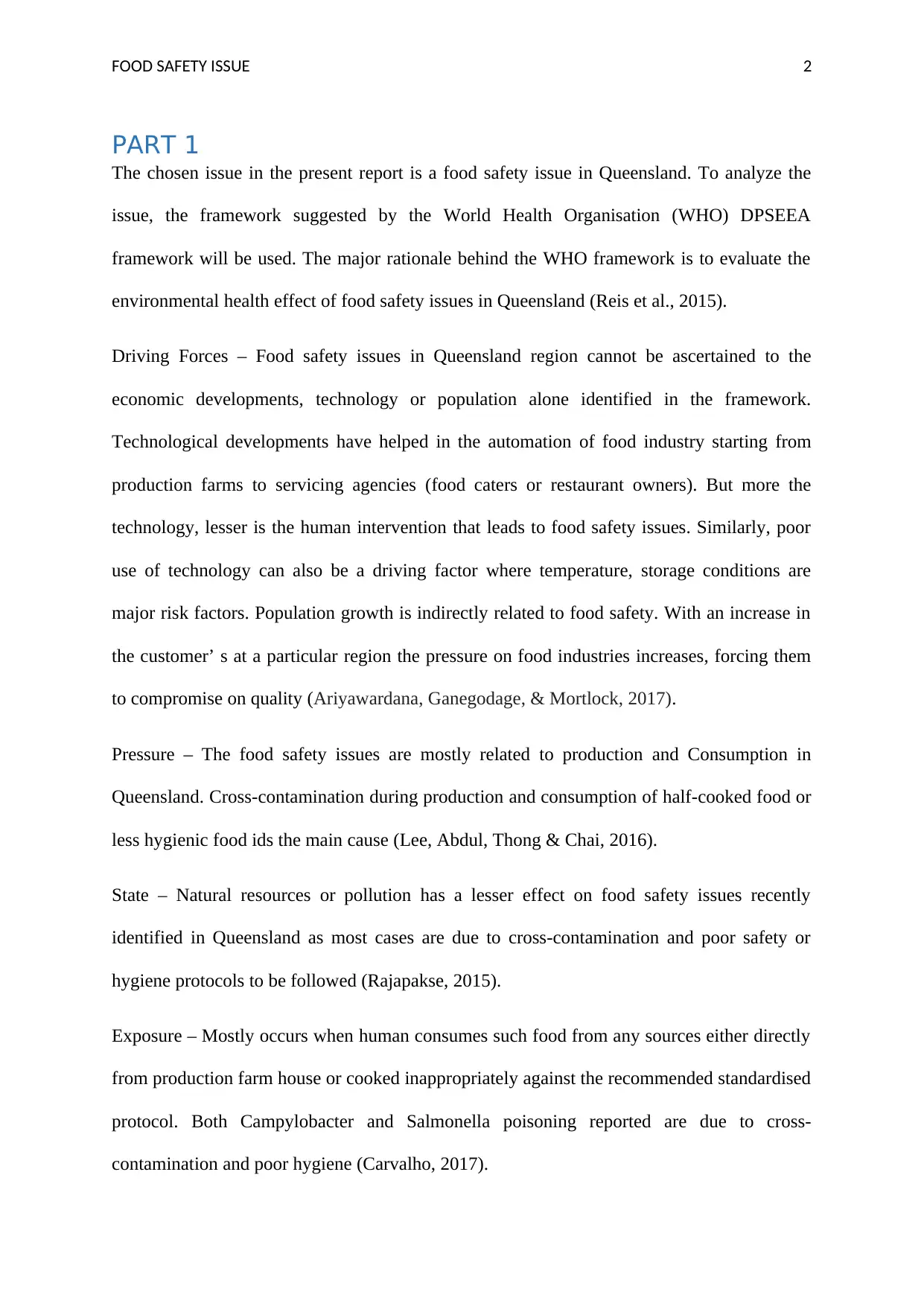
FOOD SAFETY ISSUE 2
PART 1
The chosen issue in the present report is a food safety issue in Queensland. To analyze the
issue, the framework suggested by the World Health Organisation (WHO) DPSEEA
framework will be used. The major rationale behind the WHO framework is to evaluate the
environmental health effect of food safety issues in Queensland (Reis et al., 2015).
Driving Forces – Food safety issues in Queensland region cannot be ascertained to the
economic developments, technology or population alone identified in the framework.
Technological developments have helped in the automation of food industry starting from
production farms to servicing agencies (food caters or restaurant owners). But more the
technology, lesser is the human intervention that leads to food safety issues. Similarly, poor
use of technology can also be a driving factor where temperature, storage conditions are
major risk factors. Population growth is indirectly related to food safety. With an increase in
the customer’ s at a particular region the pressure on food industries increases, forcing them
to compromise on quality (Ariyawardana, Ganegodage, & Mortlock, 2017).
Pressure – The food safety issues are mostly related to production and Consumption in
Queensland. Cross-contamination during production and consumption of half-cooked food or
less hygienic food ids the main cause (Lee, Abdul, Thong & Chai, 2016).
State – Natural resources or pollution has a lesser effect on food safety issues recently
identified in Queensland as most cases are due to cross-contamination and poor safety or
hygiene protocols to be followed (Rajapakse, 2015).
Exposure – Mostly occurs when human consumes such food from any sources either directly
from production farm house or cooked inappropriately against the recommended standardised
protocol. Both Campylobacter and Salmonella poisoning reported are due to cross-
contamination and poor hygiene (Carvalho, 2017).
PART 1
The chosen issue in the present report is a food safety issue in Queensland. To analyze the
issue, the framework suggested by the World Health Organisation (WHO) DPSEEA
framework will be used. The major rationale behind the WHO framework is to evaluate the
environmental health effect of food safety issues in Queensland (Reis et al., 2015).
Driving Forces – Food safety issues in Queensland region cannot be ascertained to the
economic developments, technology or population alone identified in the framework.
Technological developments have helped in the automation of food industry starting from
production farms to servicing agencies (food caters or restaurant owners). But more the
technology, lesser is the human intervention that leads to food safety issues. Similarly, poor
use of technology can also be a driving factor where temperature, storage conditions are
major risk factors. Population growth is indirectly related to food safety. With an increase in
the customer’ s at a particular region the pressure on food industries increases, forcing them
to compromise on quality (Ariyawardana, Ganegodage, & Mortlock, 2017).
Pressure – The food safety issues are mostly related to production and Consumption in
Queensland. Cross-contamination during production and consumption of half-cooked food or
less hygienic food ids the main cause (Lee, Abdul, Thong & Chai, 2016).
State – Natural resources or pollution has a lesser effect on food safety issues recently
identified in Queensland as most cases are due to cross-contamination and poor safety or
hygiene protocols to be followed (Rajapakse, 2015).
Exposure – Mostly occurs when human consumes such food from any sources either directly
from production farm house or cooked inappropriately against the recommended standardised
protocol. Both Campylobacter and Salmonella poisoning reported are due to cross-
contamination and poor hygiene (Carvalho, 2017).
⊘ This is a preview!⊘
Do you want full access?
Subscribe today to unlock all pages.

Trusted by 1+ million students worldwide
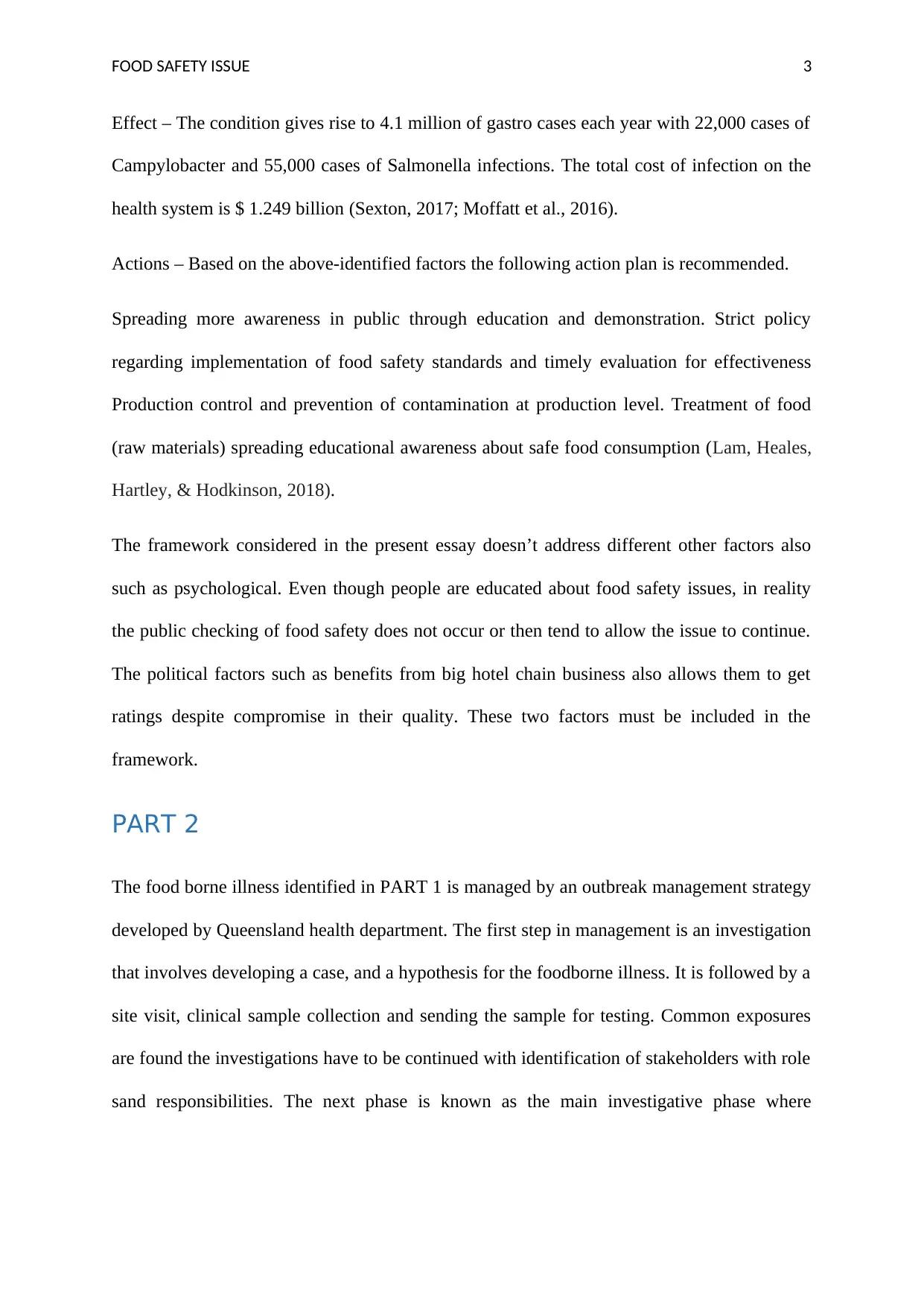
FOOD SAFETY ISSUE 3
Effect – The condition gives rise to 4.1 million of gastro cases each year with 22,000 cases of
Campylobacter and 55,000 cases of Salmonella infections. The total cost of infection on the
health system is $ 1.249 billion (Sexton, 2017; Moffatt et al., 2016).
Actions – Based on the above-identified factors the following action plan is recommended.
Spreading more awareness in public through education and demonstration. Strict policy
regarding implementation of food safety standards and timely evaluation for effectiveness
Production control and prevention of contamination at production level. Treatment of food
(raw materials) spreading educational awareness about safe food consumption (Lam, Heales,
Hartley, & Hodkinson, 2018).
The framework considered in the present essay doesn’t address different other factors also
such as psychological. Even though people are educated about food safety issues, in reality
the public checking of food safety does not occur or then tend to allow the issue to continue.
The political factors such as benefits from big hotel chain business also allows them to get
ratings despite compromise in their quality. These two factors must be included in the
framework.
PART 2
The food borne illness identified in PART 1 is managed by an outbreak management strategy
developed by Queensland health department. The first step in management is an investigation
that involves developing a case, and a hypothesis for the foodborne illness. It is followed by a
site visit, clinical sample collection and sending the sample for testing. Common exposures
are found the investigations have to be continued with identification of stakeholders with role
sand responsibilities. The next phase is known as the main investigative phase where
Effect – The condition gives rise to 4.1 million of gastro cases each year with 22,000 cases of
Campylobacter and 55,000 cases of Salmonella infections. The total cost of infection on the
health system is $ 1.249 billion (Sexton, 2017; Moffatt et al., 2016).
Actions – Based on the above-identified factors the following action plan is recommended.
Spreading more awareness in public through education and demonstration. Strict policy
regarding implementation of food safety standards and timely evaluation for effectiveness
Production control and prevention of contamination at production level. Treatment of food
(raw materials) spreading educational awareness about safe food consumption (Lam, Heales,
Hartley, & Hodkinson, 2018).
The framework considered in the present essay doesn’t address different other factors also
such as psychological. Even though people are educated about food safety issues, in reality
the public checking of food safety does not occur or then tend to allow the issue to continue.
The political factors such as benefits from big hotel chain business also allows them to get
ratings despite compromise in their quality. These two factors must be included in the
framework.
PART 2
The food borne illness identified in PART 1 is managed by an outbreak management strategy
developed by Queensland health department. The first step in management is an investigation
that involves developing a case, and a hypothesis for the foodborne illness. It is followed by a
site visit, clinical sample collection and sending the sample for testing. Common exposures
are found the investigations have to be continued with identification of stakeholders with role
sand responsibilities. The next phase is known as the main investigative phase where
Paraphrase This Document
Need a fresh take? Get an instant paraphrase of this document with our AI Paraphraser

FOOD SAFETY ISSUE 4
interviews with victims must be conducted and a descriptive approach must be taken to
gather demographic data.
The further hypothesis must be made, to evaluate whether the current case of outbreak need
an epidemiological analysis or not. An epidemiological analysis is warranted it warrants the
collection of more samples, analysing human, & non-human factors involved in the outbreak,
investigating the source and spread of the outbreak and taking a fundamental approach
towards control and prevention as per public health risk guidelines. The communication must
be carried out with the appropriate team as per the requirement. In each step documentation is
mandatory, and circulation of data via information technology is crucial. Once, the current
analysis is complete; the next step is step down approach where the end of the outbreak is to
be ensured (Department oF health, 2018).
In the context of roles and responsibilities, different organisations and units are involved from
the start and end of an outbreak. In this section, different units and organisations are involved
in the control of the outbreak are mentioned below.
Public Health Units – They are the first organisation to initiate an outbreak control and
management protocol. Once an outbreak is identified, the PHU’s responsibility is declaring
an outbreak and communicating the outbreak to OzFoodNet through the mail. Necessary
local protocol along with Queensland Health protocol to be followed for clinical investigation
of an outbreak (Parisi et al., 2019).
Communicable dIsease Branch – The roles and responsibilities of communicable disease
branch are to communicate with the team ( incident management team), participating with
local or cross-boundary units when necessary, review guidelines in the context of foodborne
illness and advice the different organizations involved regarding the review guidelines
(Varrone et al., 2018).
interviews with victims must be conducted and a descriptive approach must be taken to
gather demographic data.
The further hypothesis must be made, to evaluate whether the current case of outbreak need
an epidemiological analysis or not. An epidemiological analysis is warranted it warrants the
collection of more samples, analysing human, & non-human factors involved in the outbreak,
investigating the source and spread of the outbreak and taking a fundamental approach
towards control and prevention as per public health risk guidelines. The communication must
be carried out with the appropriate team as per the requirement. In each step documentation is
mandatory, and circulation of data via information technology is crucial. Once, the current
analysis is complete; the next step is step down approach where the end of the outbreak is to
be ensured (Department oF health, 2018).
In the context of roles and responsibilities, different organisations and units are involved from
the start and end of an outbreak. In this section, different units and organisations are involved
in the control of the outbreak are mentioned below.
Public Health Units – They are the first organisation to initiate an outbreak control and
management protocol. Once an outbreak is identified, the PHU’s responsibility is declaring
an outbreak and communicating the outbreak to OzFoodNet through the mail. Necessary
local protocol along with Queensland Health protocol to be followed for clinical investigation
of an outbreak (Parisi et al., 2019).
Communicable dIsease Branch – The roles and responsibilities of communicable disease
branch are to communicate with the team ( incident management team), participating with
local or cross-boundary units when necessary, review guidelines in the context of foodborne
illness and advice the different organizations involved regarding the review guidelines
(Varrone et al., 2018).
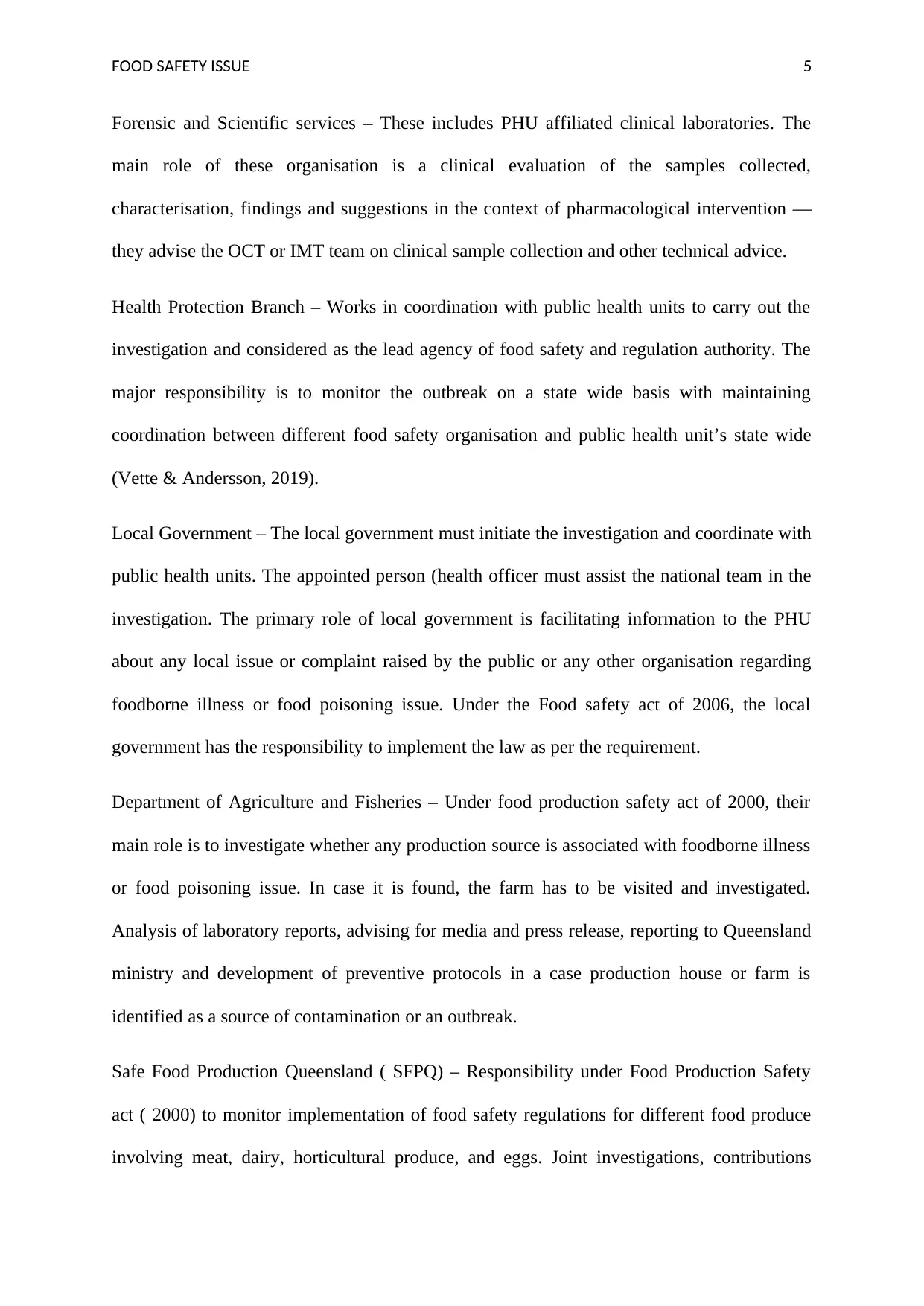
FOOD SAFETY ISSUE 5
Forensic and Scientific services – These includes PHU affiliated clinical laboratories. The
main role of these organisation is a clinical evaluation of the samples collected,
characterisation, findings and suggestions in the context of pharmacological intervention —
they advise the OCT or IMT team on clinical sample collection and other technical advice.
Health Protection Branch – Works in coordination with public health units to carry out the
investigation and considered as the lead agency of food safety and regulation authority. The
major responsibility is to monitor the outbreak on a state wide basis with maintaining
coordination between different food safety organisation and public health unit’s state wide
(Vette & Andersson, 2019).
Local Government – The local government must initiate the investigation and coordinate with
public health units. The appointed person (health officer must assist the national team in the
investigation. The primary role of local government is facilitating information to the PHU
about any local issue or complaint raised by the public or any other organisation regarding
foodborne illness or food poisoning issue. Under the Food safety act of 2006, the local
government has the responsibility to implement the law as per the requirement.
Department of Agriculture and Fisheries – Under food production safety act of 2000, their
main role is to investigate whether any production source is associated with foodborne illness
or food poisoning issue. In case it is found, the farm has to be visited and investigated.
Analysis of laboratory reports, advising for media and press release, reporting to Queensland
ministry and development of preventive protocols in a case production house or farm is
identified as a source of contamination or an outbreak.
Safe Food Production Queensland ( SFPQ) – Responsibility under Food Production Safety
act ( 2000) to monitor implementation of food safety regulations for different food produce
involving meat, dairy, horticultural produce, and eggs. Joint investigations, contributions
Forensic and Scientific services – These includes PHU affiliated clinical laboratories. The
main role of these organisation is a clinical evaluation of the samples collected,
characterisation, findings and suggestions in the context of pharmacological intervention —
they advise the OCT or IMT team on clinical sample collection and other technical advice.
Health Protection Branch – Works in coordination with public health units to carry out the
investigation and considered as the lead agency of food safety and regulation authority. The
major responsibility is to monitor the outbreak on a state wide basis with maintaining
coordination between different food safety organisation and public health unit’s state wide
(Vette & Andersson, 2019).
Local Government – The local government must initiate the investigation and coordinate with
public health units. The appointed person (health officer must assist the national team in the
investigation. The primary role of local government is facilitating information to the PHU
about any local issue or complaint raised by the public or any other organisation regarding
foodborne illness or food poisoning issue. Under the Food safety act of 2006, the local
government has the responsibility to implement the law as per the requirement.
Department of Agriculture and Fisheries – Under food production safety act of 2000, their
main role is to investigate whether any production source is associated with foodborne illness
or food poisoning issue. In case it is found, the farm has to be visited and investigated.
Analysis of laboratory reports, advising for media and press release, reporting to Queensland
ministry and development of preventive protocols in a case production house or farm is
identified as a source of contamination or an outbreak.
Safe Food Production Queensland ( SFPQ) – Responsibility under Food Production Safety
act ( 2000) to monitor implementation of food safety regulations for different food produce
involving meat, dairy, horticultural produce, and eggs. Joint investigations, contributions
⊘ This is a preview!⊘
Do you want full access?
Subscribe today to unlock all pages.

Trusted by 1+ million students worldwide

FOOD SAFETY ISSUE 6
towards media and press release, auditing, accreditation to business and food owners against
the regulations and guidelines followed.
Public – Must report to the local council for any such incidences for further investigation.
Thus, the above stakeholders are involved in the case of Queensland food safety issues, and
the current management protocol involves such steps. The coordination between local and
federal teams is important for successful identification and prevention of any foodborne
illness issue as per food safety guidelines.
Based on the analysis of existing management strategy and protocol the following
recommendations need to be implemented concerned with food safety issues identified.
The monitoring agencies should move to more fieldwork as compared to paperwork. For
example, high rating eateries and restaurants are seldom checked for their food safety
standards and protocols once the evaluation and rating are given. The public trust also
increases in that context. However, any such issue can put public health at risk demanding
immediate attention. Such cases can be prevented when monitoring and controlling agency
have better control over the implemented systems.
Secondly, in recent years the number of outbreaks and food poisoning issues has increased
with an increase in the number of microorganisms involved in the outbreak. Such increase in
microorganisms responsible for outbreak must be monitored by public health agencies, and a
standardized protocol must be developed for screening and prevention. Tieing up with
academic laboratories or clinical industries for the development of testing kits can save a
significant amount of cost and time involved in outbreak control and prevention before the
occurrence.
They are conducting workshops for business owners, health officers, and the public
simultaneously ensuring active involvement of all the three groups. This will ensure the
towards media and press release, auditing, accreditation to business and food owners against
the regulations and guidelines followed.
Public – Must report to the local council for any such incidences for further investigation.
Thus, the above stakeholders are involved in the case of Queensland food safety issues, and
the current management protocol involves such steps. The coordination between local and
federal teams is important for successful identification and prevention of any foodborne
illness issue as per food safety guidelines.
Based on the analysis of existing management strategy and protocol the following
recommendations need to be implemented concerned with food safety issues identified.
The monitoring agencies should move to more fieldwork as compared to paperwork. For
example, high rating eateries and restaurants are seldom checked for their food safety
standards and protocols once the evaluation and rating are given. The public trust also
increases in that context. However, any such issue can put public health at risk demanding
immediate attention. Such cases can be prevented when monitoring and controlling agency
have better control over the implemented systems.
Secondly, in recent years the number of outbreaks and food poisoning issues has increased
with an increase in the number of microorganisms involved in the outbreak. Such increase in
microorganisms responsible for outbreak must be monitored by public health agencies, and a
standardized protocol must be developed for screening and prevention. Tieing up with
academic laboratories or clinical industries for the development of testing kits can save a
significant amount of cost and time involved in outbreak control and prevention before the
occurrence.
They are conducting workshops for business owners, health officers, and the public
simultaneously ensuring active involvement of all the three groups. This will ensure the
Paraphrase This Document
Need a fresh take? Get an instant paraphrase of this document with our AI Paraphraser

FOOD SAFETY ISSUE 7
stakeholders are aware of the new developments in foodborne illness trajectory; the public is
aware of their roles, responsibilities, and factors to be monitored and as a business owner
what role they should play to improve the food safety standards and how it would benefit
them. Such workshops at a regular frequency can improvise the standards of food safety in
the Queensland area. The more aware the population, the better is the control over the issue
informally.
CONCLUSION
Thus in the present analysis, it is found that foodborne illness is a severe issue that needs a
collaborative and interactive approach towards control and prevention.
REFERENCES
Ariyawardana, A., Ganegodage, K., & Mortlock, M. Y. (2017). Consumers' trust in vegetable
supply chain members and their behavioural responses: A study based in Queensland,
Australia. Food control, 73, 193-201.
Carvalho, F. P. (2017). Pesticides, environment, and food safety. Food and Energy
Security, 6(2), 48-60.
stakeholders are aware of the new developments in foodborne illness trajectory; the public is
aware of their roles, responsibilities, and factors to be monitored and as a business owner
what role they should play to improve the food safety standards and how it would benefit
them. Such workshops at a regular frequency can improvise the standards of food safety in
the Queensland area. The more aware the population, the better is the control over the issue
informally.
CONCLUSION
Thus in the present analysis, it is found that foodborne illness is a severe issue that needs a
collaborative and interactive approach towards control and prevention.
REFERENCES
Ariyawardana, A., Ganegodage, K., & Mortlock, M. Y. (2017). Consumers' trust in vegetable
supply chain members and their behavioural responses: A study based in Queensland,
Australia. Food control, 73, 193-201.
Carvalho, F. P. (2017). Pesticides, environment, and food safety. Food and Energy
Security, 6(2), 48-60.
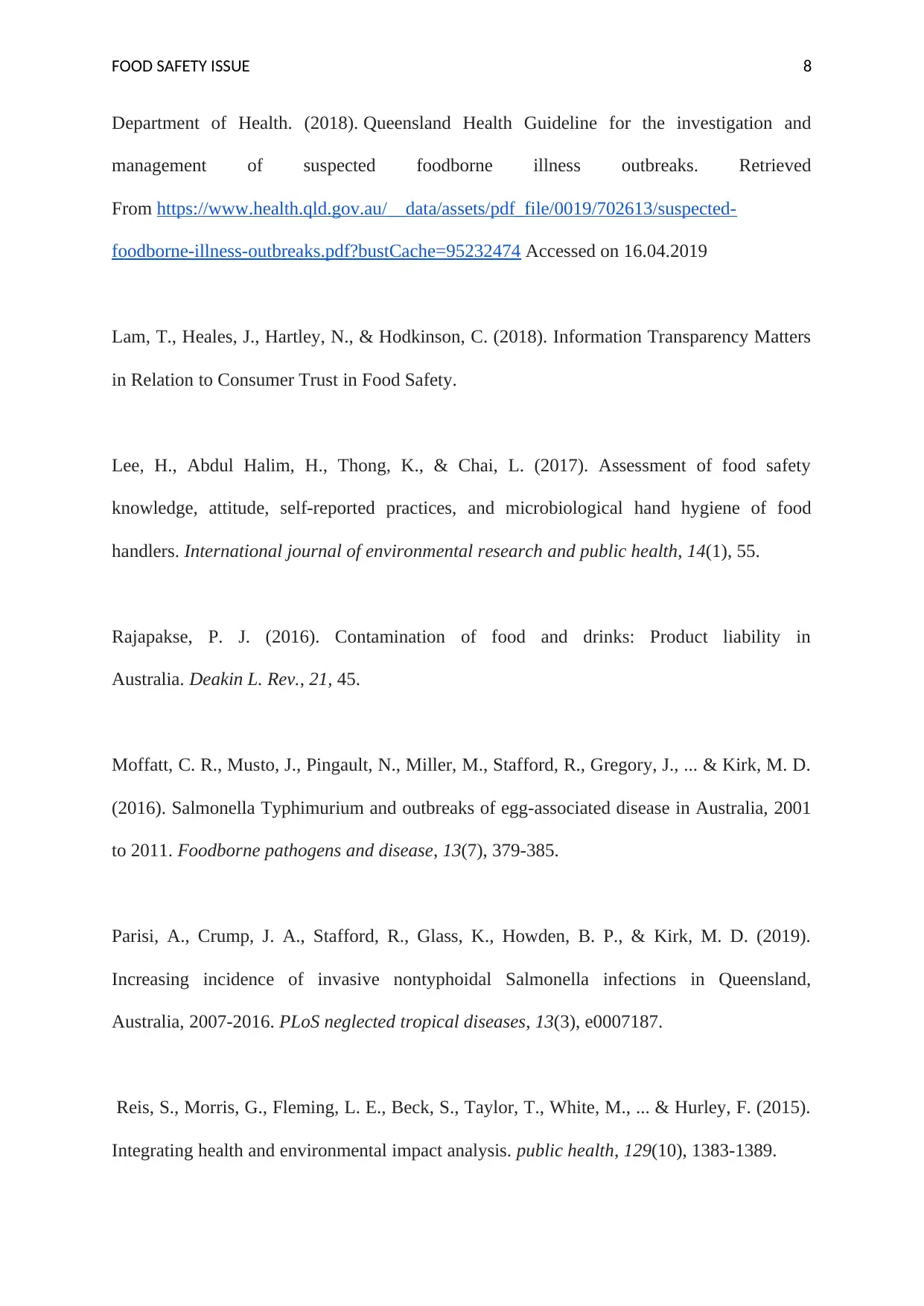
FOOD SAFETY ISSUE 8
Department of Health. (2018). Queensland Health Guideline for the investigation and
management of suspected foodborne illness outbreaks. Retrieved
From https://www.health.qld.gov.au/__data/assets/pdf_file/0019/702613/suspected-
foodborne-illness-outbreaks.pdf?bustCache=95232474 Accessed on 16.04.2019
Lam, T., Heales, J., Hartley, N., & Hodkinson, C. (2018). Information Transparency Matters
in Relation to Consumer Trust in Food Safety.
Lee, H., Abdul Halim, H., Thong, K., & Chai, L. (2017). Assessment of food safety
knowledge, attitude, self-reported practices, and microbiological hand hygiene of food
handlers. International journal of environmental research and public health, 14(1), 55.
Rajapakse, P. J. (2016). Contamination of food and drinks: Product liability in
Australia. Deakin L. Rev., 21, 45.
Moffatt, C. R., Musto, J., Pingault, N., Miller, M., Stafford, R., Gregory, J., ... & Kirk, M. D.
(2016). Salmonella Typhimurium and outbreaks of egg-associated disease in Australia, 2001
to 2011. Foodborne pathogens and disease, 13(7), 379-385.
Parisi, A., Crump, J. A., Stafford, R., Glass, K., Howden, B. P., & Kirk, M. D. (2019).
Increasing incidence of invasive nontyphoidal Salmonella infections in Queensland,
Australia, 2007-2016. PLoS neglected tropical diseases, 13(3), e0007187.
Reis, S., Morris, G., Fleming, L. E., Beck, S., Taylor, T., White, M., ... & Hurley, F. (2015).
Integrating health and environmental impact analysis. public health, 129(10), 1383-1389.
Department of Health. (2018). Queensland Health Guideline for the investigation and
management of suspected foodborne illness outbreaks. Retrieved
From https://www.health.qld.gov.au/__data/assets/pdf_file/0019/702613/suspected-
foodborne-illness-outbreaks.pdf?bustCache=95232474 Accessed on 16.04.2019
Lam, T., Heales, J., Hartley, N., & Hodkinson, C. (2018). Information Transparency Matters
in Relation to Consumer Trust in Food Safety.
Lee, H., Abdul Halim, H., Thong, K., & Chai, L. (2017). Assessment of food safety
knowledge, attitude, self-reported practices, and microbiological hand hygiene of food
handlers. International journal of environmental research and public health, 14(1), 55.
Rajapakse, P. J. (2016). Contamination of food and drinks: Product liability in
Australia. Deakin L. Rev., 21, 45.
Moffatt, C. R., Musto, J., Pingault, N., Miller, M., Stafford, R., Gregory, J., ... & Kirk, M. D.
(2016). Salmonella Typhimurium and outbreaks of egg-associated disease in Australia, 2001
to 2011. Foodborne pathogens and disease, 13(7), 379-385.
Parisi, A., Crump, J. A., Stafford, R., Glass, K., Howden, B. P., & Kirk, M. D. (2019).
Increasing incidence of invasive nontyphoidal Salmonella infections in Queensland,
Australia, 2007-2016. PLoS neglected tropical diseases, 13(3), e0007187.
Reis, S., Morris, G., Fleming, L. E., Beck, S., Taylor, T., White, M., ... & Hurley, F. (2015).
Integrating health and environmental impact analysis. public health, 129(10), 1383-1389.
⊘ This is a preview!⊘
Do you want full access?
Subscribe today to unlock all pages.

Trusted by 1+ million students worldwide
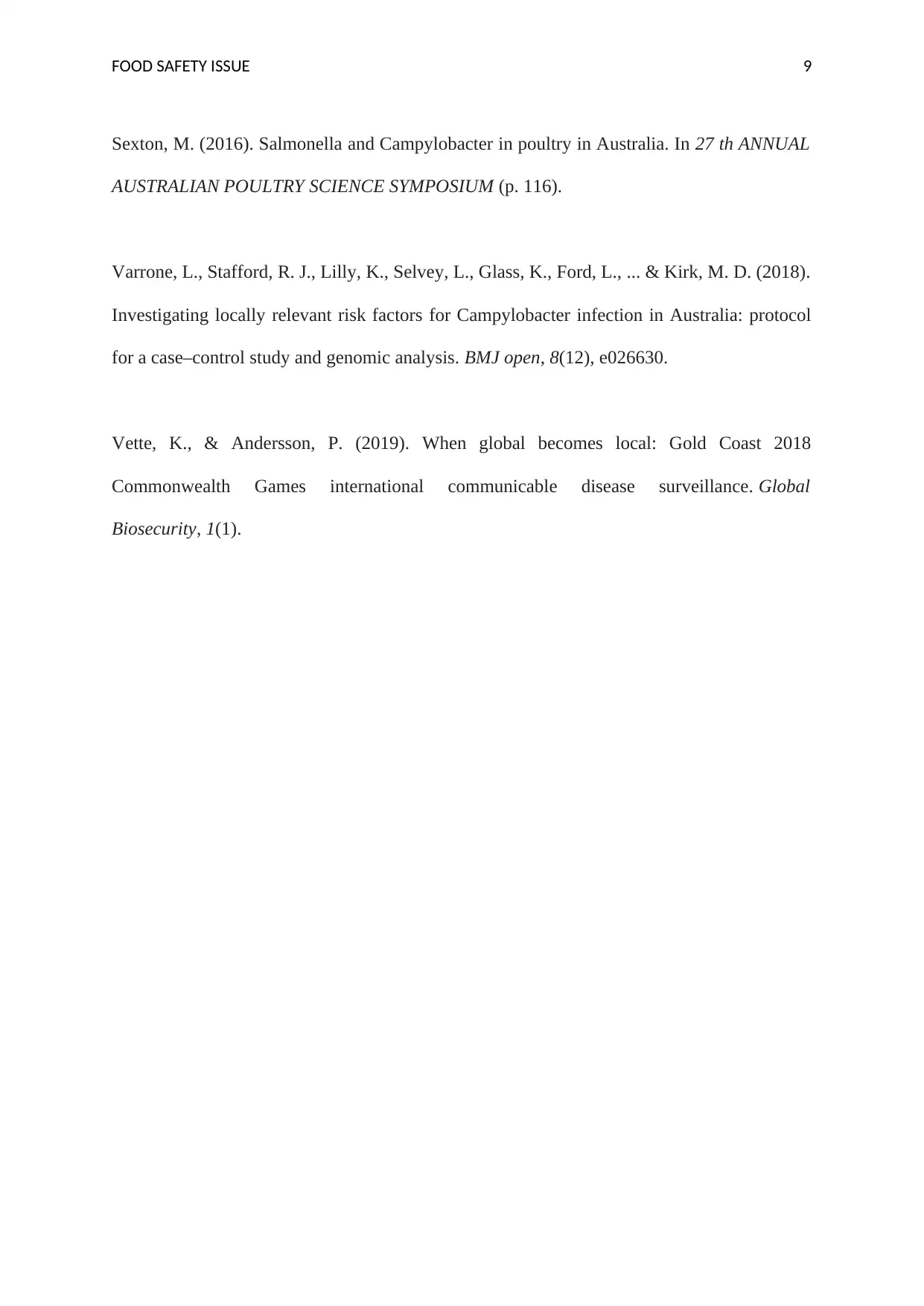
FOOD SAFETY ISSUE 9
Sexton, M. (2016). Salmonella and Campylobacter in poultry in Australia. In 27 th ANNUAL
AUSTRALIAN POULTRY SCIENCE SYMPOSIUM (p. 116).
Varrone, L., Stafford, R. J., Lilly, K., Selvey, L., Glass, K., Ford, L., ... & Kirk, M. D. (2018).
Investigating locally relevant risk factors for Campylobacter infection in Australia: protocol
for a case–control study and genomic analysis. BMJ open, 8(12), e026630.
Vette, K., & Andersson, P. (2019). When global becomes local: Gold Coast 2018
Commonwealth Games international communicable disease surveillance. Global
Biosecurity, 1(1).
Sexton, M. (2016). Salmonella and Campylobacter in poultry in Australia. In 27 th ANNUAL
AUSTRALIAN POULTRY SCIENCE SYMPOSIUM (p. 116).
Varrone, L., Stafford, R. J., Lilly, K., Selvey, L., Glass, K., Ford, L., ... & Kirk, M. D. (2018).
Investigating locally relevant risk factors for Campylobacter infection in Australia: protocol
for a case–control study and genomic analysis. BMJ open, 8(12), e026630.
Vette, K., & Andersson, P. (2019). When global becomes local: Gold Coast 2018
Commonwealth Games international communicable disease surveillance. Global
Biosecurity, 1(1).
1 out of 10
Related Documents
Your All-in-One AI-Powered Toolkit for Academic Success.
+13062052269
info@desklib.com
Available 24*7 on WhatsApp / Email
![[object Object]](/_next/static/media/star-bottom.7253800d.svg)
Unlock your academic potential
Copyright © 2020–2025 A2Z Services. All Rights Reserved. Developed and managed by ZUCOL.





